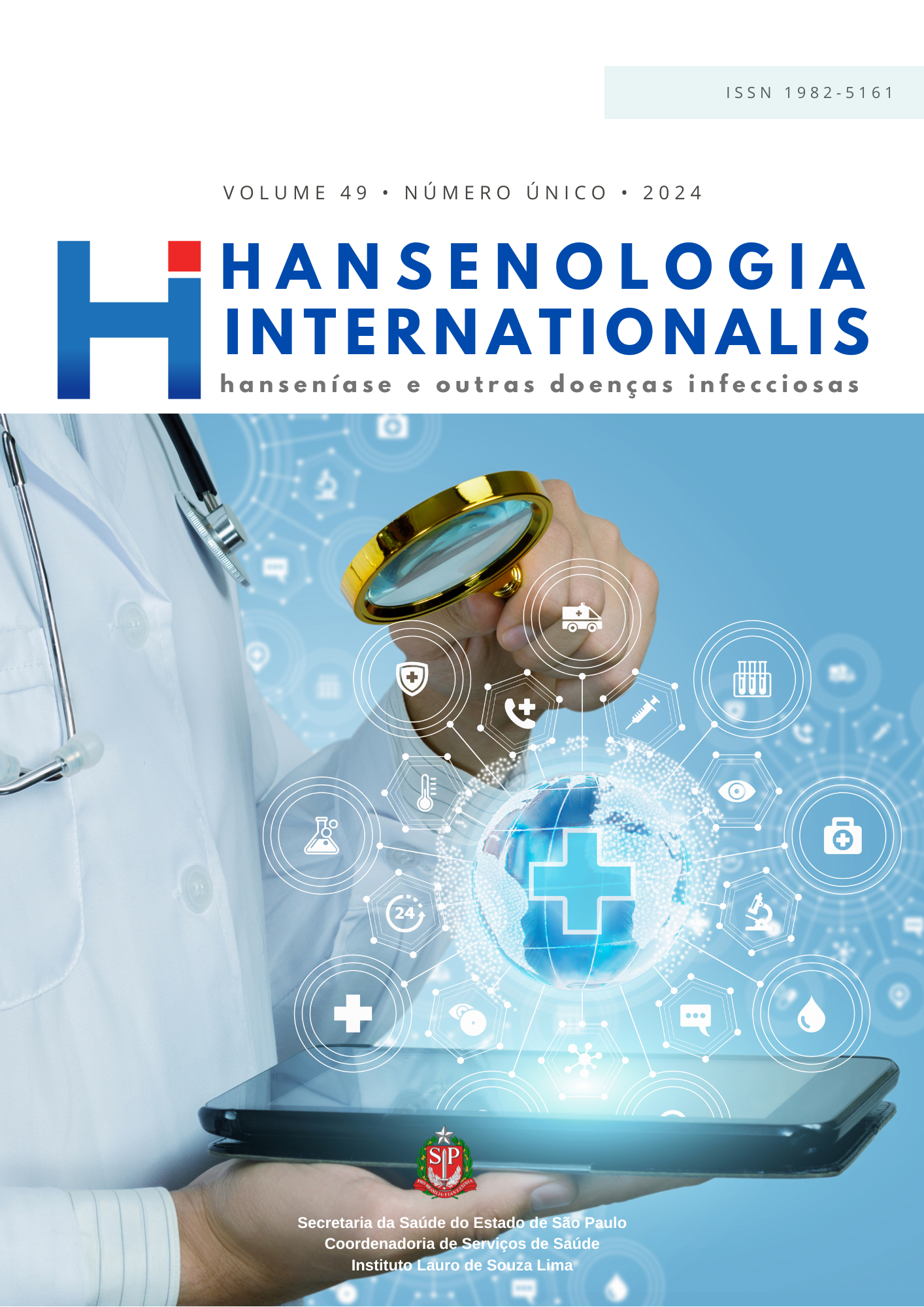Abstract
Introduction: leprosy is caused by the bacillus Mycobacterium leprae and affects the skin and/or peripheral nerves. Adverse reactions to medications used in the treatment of the disease have been reported in the literature. Objective: to report the case of a patient who experienced a severe adverse reaction to dapsone in the treatment of leprosy. Case description: a 51-year-old female patient sought care at the dermatology outpatient clinic of Lauro Wanderley University Hospital of the Federal University of Paraíba, linked to the Brazilian Hospital Services Company, complaining of spots on her lower limbs for three years. Physical examination revealed erythematous-brown macules with altered sensitivity in the lower limbs. A biopsy of the lesions and a skin smear bacilloscopy were performed, confirming the diagnosis of leprosy, leading to the initiation of multidrug therapy, single regimen. After three weeks, the patient developed hemolytic anemia caused by dapsone, necessitating the suspension of multidrug therapy, single regimen, and the prescription of two hemoconcentrates and intravenous hydrocortisone, with satisfactory progress. Discussion: there are reports in the literature of adverse reactions to multidrug therapy, single regimen, with an emphasis on dapsone. Hemolytic anemia is one of the most common adverse effects. However, the patient’s low hemoglobin levels differed from findings in previous studies, making it necessary to suspend the medications. Conclusions: the case highlights severe anemia, emphasizing the relevance of an interdisciplinary approach and meticulous attention to patients undergoing such therapeutic regimens.
References
1. World Health Organization. Guidelines for the diagnosis, treatment and prevention of leprosy. Regional Office for South-East Asia: WHO; 2018. 106 p. [cited 2024 May 10]. Available from: https://iris.who.int/bitstream/handle/10665/274127/9789290226383-eng.pdf.
2. Ministério da Saúde (Brasil). Boletim epidemiológico: hanseníase – 2022. Brasília: Ministério da Saúde; 2022. 54 p. [acesso em 29 jul. 2023]. Disponível em: http://antigo.aids.gov.br/system/tdf/pub/2016/68371/boletim_hanseniase_2022_versao_web_24.01.22.pdf?file=1&type=node&id=68371&force=1.
3. Ministério da Saúde (Brasil). Guia para o controle da hanseníase. Brasília: Ministério da Saúde; 2002. 89 p. [acesso em 10 maio 2024]. Disponível em: https://bvsms.saude.gov.br/bvs/publicacoes/guia_de_hanseniase.pdf.
4. Hilder R, Lockwood D. The adverse drug effects of dapsone therapy in leprosy: a systematic review. Lepr Rev. 2020;91(3):232-43. doi: http://dx.doi.org/10.47276/lr.91.3.232.
5. Deps P, Guerra P, Nasser S, Simon M. Hemolytic anemia in patients receiving daily dapsone for the treatment of leprosy. Lepr Rev. 2012;83(3):305-7. doi: http://dx.doi.org/10.47276/lr.83.3.305.
6. Ministério da Saúde (Brasil). Nota técnica nº 16/2021-CGDE/. DCCI/SVS/MS. Brasília: Ministério da Saúde; 2021. [acesso em 29 jul. 2023]. Disponível em: http://antigo.aids.gov.br/system/tdf/legislacao/2021/notas_tecnicas/nota_tecnica_n162021-cgdedccisvsms.pdf?file=1&type=node&id=67997&force=1.
7. Propércio ANA, Oliveira FA, Vale TN, Bandeira DR, Marinho AMS. O tratamento da hanseníase a partir de uma revisão integrativa. Braz J Hea Rev. 2021;4(2):8076-101. doi: https://doi.org/10.34119/bjhrv4n2-339.
8. BRASIL. Ministério da Saúde. Secretaria de Ciência, Tecnologia, Inovação e Insumos Estratégicos em Saúde. Portaria SCTIE/MS nº 67, de 7 de julho de 2022. Torna pública a decisão de aprovar, no âmbito do Sistema Único de Saúde – SUS, o Protocolo Clínico e Diretrizes Terapêuticas da Hanseníase. Brasília: Ministério da Saúde; 2022. [citado em 29 jul. 2023]. Disponível em: https://www.gov.br/conitec/pt-br/midias/protocolos/20220818_pcdt_hanseniase.pdf.
9. Bucaretchi F, Vicente DC, Pereira RM, Tresoldi AT. Dapsone hypersensitivity syndrome in an adolescent during treatment of leprosy. Rev Inst Med trop S Paulo. 2004;46(6):331-4. doi: https://doi.org/10.1590/s0036-46652004000600006.
10. Maciel LG, França LAA, Deus BV, Formiga CCS. Acute pancreatitis associated with multibacillary polychemotherapy for leprosy. Rev Inst Med Trop São Paulo. 2021;63(73):1-5. doi: http://doi.org/10.1590/S1678-9946202163073.
11. Tortelly VD, Daxbacher EL, Brotas AM, Carneiro S. Adverse effects of polychemotherapy for leprosy in 13 years of follow-up at a university hospital. An Bras Dermatol. 2021;96(2):224-7. doi: https://doi.org/10.1016/j.abd.2020.07.005.
12. Singh H, Nel B, Dey V, Tiwari P, Dulhani N. Adverse effects of multi-drug therapy in leprosy, a two years’ experience (2006-2008) in tertiary health care centre in the tribal region of Chhattisgarh state (Bastar, Jagdalpur). Lepr Rev. 2011;82(1):17-24. doi: https://doi.org/10.47276/lr.82.1.17.

This work is licensed under a Creative Commons Attribution 4.0 International License.
Copyright (c) 2024 Maria Eduarda Gomes Rodrigues, Joanne Elizabeth Ferraz da Costa, Esther Bastos Palitot
